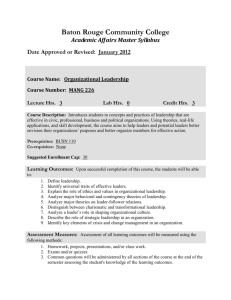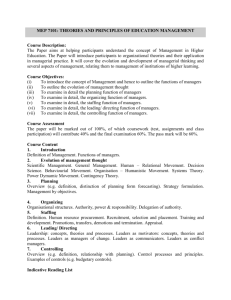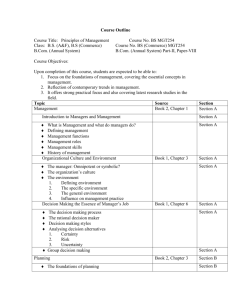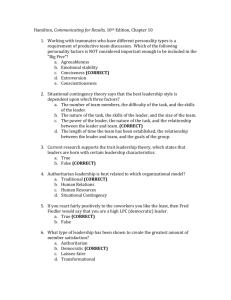LEADERSHIP NOTES
advertisement
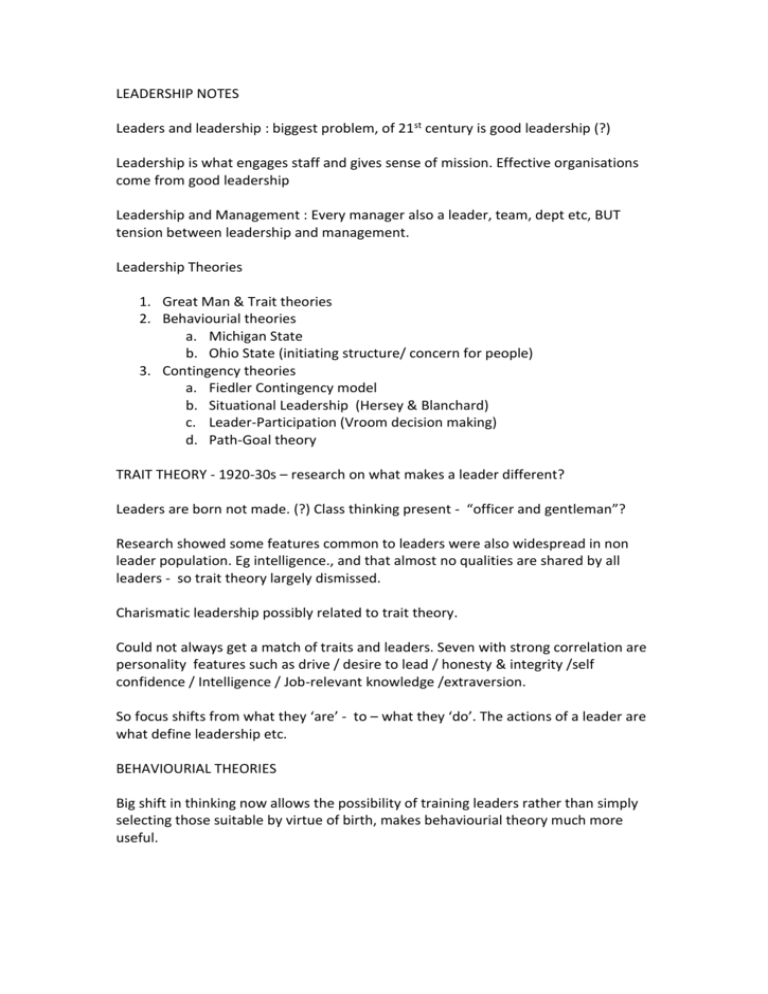
LEADERSHIP NOTES Leaders and leadership : biggest problem, of 21st century is good leadership (?) Leadership is what engages staff and gives sense of mission. Effective organisations come from good leadership Leadership and Management : Every manager also a leader, team, dept etc, BUT tension between leadership and management. Leadership Theories 1. Great Man & Trait theories 2. Behaviourial theories a. Michigan State b. Ohio State (initiating structure/ concern for people) 3. Contingency theories a. Fiedler Contingency model b. Situational Leadership (Hersey & Blanchard) c. Leader-Participation (Vroom decision making) d. Path-Goal theory TRAIT THEORY - 1920-30s – research on what makes a leader different? Leaders are born not made. (?) Class thinking present - “officer and gentleman”? Research showed some features common to leaders were also widespread in non leader population. Eg intelligence., and that almost no qualities are shared by all leaders - so trait theory largely dismissed. Charismatic leadership possibly related to trait theory. Could not always get a match of traits and leaders. Seven with strong correlation are personality features such as drive / desire to lead / honesty & integrity /self confidence / Intelligence / Job-relevant knowledge /extraversion. So focus shifts from what they ‘are’ - to – what they ‘do’. The actions of a leader are what define leadership etc. BEHAVIOURIAL THEORIES Big shift in thinking now allows the possibility of training leaders rather than simply selecting those suitable by virtue of birth, makes behaviourial theory much more useful. Four models under this heading. ONE: University of Iowa. Autocratic /boss centred Centred on boss / authoritative / no input from staff / ‘strong’ leadership model / fast decisions on incomplete information(?) Extreme example would be army / narrow span of control / tall organisations Traditional / old school thinking / Taylorism fits well. Often works well with manager present but productivity falls away when manager not on task. Also staff often resent the typically close form of management, hostile to management (Herzberg relevance) Democratic / employee centred Team based / seeking input from other well qualified and respected staff / ‘consensus’ leadership / slow decisions with full info input. Typical of flat organisation / modern well qualified staff / better for motivation and training - evidence of continued productivity even in absence of manager. Employee empowerment relevance. Q: Which is better in time of crisis? Time of change ? Laissez faire ‘Hands off’ management style / team makes own decisions around work, routines etc and is responsible for output / high level of trust / extreme theory Y position. Consultative / paternalistic /persuasive - other flavours of these stylings. TWO: University of Ohio Beginnings of task- people culture thinking (building on Mayo (?) human relations school) Condense all leader/ manager behaviour down and two themes emerge which are: Initiating structure - degree to which manager set outs expectations, rules around work, task definition, performance levels etc and defines roles for all involved. Can be high or low. (products/ outcomes/ task) Consideration - degree to which the manager shows ‘caring’ feelings for staff, and looks to develop relationships based on trust, respects etc, as well as work focus. (process/ people/ relationships) Ideal leader is high - high. Although it is possible to be low-high and still successful. Depends on the situation. Eg start-ups or corporation. Very significant influence on other work in this area. Similar to Uni of Michigan – favoured employee oriented managers. THREE: University of Texas Blake & Mouton - Management grid. An analysis of management types. Not a theory of leadership, so possibly a diagnostic tool for thinking about extremes of management gone wrong / but no use in training etc. Styles listed as country club - too much concern for people / production will suffer task management – too much concern for production people will leave / low motivation impoverished - shouldn’t be in the job - not enough care about either. Does enough to maintain position team mgt - high performer though well managed staff/ motivation high etc. middle of the road - OK all round / balancing act of output and morale. Behaviourial theories still did not find an answer to the question what is a leader, but they did go a way to establish recognition of styles etc and that one manager/leader may be quite different to another and still do a good job ( cf trait theory thinking) But still no overall consistency – so something other than simply the way leaders behave is involved. FOUR: Tannenbaum & Schmidt put up idea that leaders could change/ be flexible in style at about this time. Breakthrough idea in thinking about managers. Three sets of forces identified - manager / subordinate / situation - all of which contribute to the leadership style that will be seen, ranging form autocratic to democratic. So is the situation of the manager important to the management style adopted? YES - Big breakthrough as now more than one way to lead. CONTINGENCY MANAGEMENT THEORIES Fiedler Contingency model Main idea is that effective group performance will come from matching leaders style of interaction with the degree to which situation allowed leader to influence etc Analysis of leader along continuum of task oriented - relationship oriented approach. Done with LPC questionnaire- bit dodgy ? This is put with situation / contingency Three factors affecting/ creating contingency are 1. Leader member relations –degree of confidence, respect, trust of supporters for leader. 2. Task structure – formalised +/or procedurised work assignments 3. Position power – degree of influence a leader has over hiring, firing, promotions, salary etc. Outputs vary along axis of combinations of contingency factors. Task best in extreme good and extreme bad / relationship better in moderate conditions. Why - extreme good - no problem so all goes well / extreme bad – remedial structure and task definition are needed and provided by task leader. Strong leader will establish that and has power some over staff so relationships are not a problem. Moderate – people power is need to lift the team performance so negotiation skills etc. Support is strong, although refining needed with additional factors. Fiedler referred to ‘high control (favourable) and low control (unfavourable) Fiedler’s view was that individuals can vary style somewhat but not greatly so it is better to try and alter contingency to match style. Gives reason for the analysis of the contingency/ style by the leader. Shift the level of control in situation to make it fit style and lift performance. Situational Leadership Model (Hersey & Blanchard) Sometimes called the lifecycle theory of management as relates to worker development (?). Focus on worker is good as it is the worker that provides the outputs of leadership. Change the leadership style of the leader in accordance with data gathered about the task readiness of the workers ranked from low (lack of ability, training, confidence) to high (strong ability, well trained, confident and willing). Different mixes of worker position( R1 R4) need a different type of management style. Low readiness - close management - telling - new worker High readiness - delegating management - delegating - trained/ mature worker New workers will probably be in R1 and develop with the organisation through to R4. The leadership/ management style is best suited to where they are on that curve. Suggestion is that workers need high task style at start/ then high task and support as they develop/gradually task needs drop away, then support as the worker reaches R4, and delegation can happen. (link to autocratic/democratic mgt) R1 - HT/LR –telling, no relationship R2 - HT/HR – selling, developing worker by rewarding skills acquisition by developing relationship, engaging in feedback etc R3 – HR/LT – participating, working ‘alongside’, sharing ideas, discussing R4 – LR/LT - delegating, relationship and responsibility set. Path-Goal Theory Two biggest contingencies are : 1– personal characteristics of workers - ability, skills, needs, motivations, degree of autonomy. 2work environment – degree of task structure, type of formal authority system, job descriptions, effect of policies and rules, work group characteristics (education level and internal relationships among workers) Based on expectancy theory (how hard do I need to work ? / what reward will I get ? / how do I feel about the reward ? ) Path-Goal is about leaders making the path for workers to get to their personal and organisational goals more attractive. This can be done by: 1. clarifying the path / making the work easier through identifying and teaching/learning methods to do it. 2. Increasing the rewards that employees value and desire and increase these, which may be either intrinsic or extrinsic. Basic theory states that the leader should try to increase the payoff to staff for goal attainment and make goal attainment more likely. Four styles of path –goal leadership. Directive – (path clarification giving clear tasks, timelines, training, guidelines) similar to initiating structure as in Ohio state) exact instructions given, planning scheduling, setting standards, ensuring adherence to standards. Supportive - friendly, showing concern for workers, backing off from close management on assumption that staff are trained and knowledgeable. team climate similar to consideration leadership. Participative – where tasks are complex and non-routine, consultation with workers is needed, team effort results. (Path clarification) opinions and suggestions of workers sought. Achievement oriented – setting high goals where a job challenge may be missing, emphasis is on high performance and improvement over current goals confidence in employees expressed. EXPECTANCY MODEL SUMMARY ( from Inkson&Kolb, 1997) EFFORT E P expectancy What is the probability that I can perform at the required level if I try? PERFORMANCE P O expectancy What is the probability that my good performance will lead to desired outcomes? OUTCOMES Valence What value do I place on the potential outcomes? Example: An Office Product sales rep (Veronica) is offered a bonus scheme which requires her to increase sales for each month from now until Dec 31, by 15 %. Sales are presently running 9% down (year-on-year ). If she achieves this target then she will receive a bonus in January next year of $1000 for each percentage point, for each month, that she exceeds the increase. Veronica may think about the bonus program, like this : E P : “ If I work really hard can I lift the sales by 15% ? They are down on last year by 9% due to the recession, and so I am going to have to recover that 9% and then increased over last year by 6%, and keep it going for six months, so I can’t load up sales in one month, or the next month will be down. If I cut price then I will hit the revenue and therefore sales will not increase as much. I should find out if we have any new products coming up. Maybe I can work some special deals around the super city ? The ICC world cup is too far away. The economy is supposed to be recovering, and there is the ICC world cup effect, - but interest rates might be going to move. Most of my customers have been cutting back so they can’t have much reserve supplies – they must be going to start ordering again soon. What I need to do is get out there and see all my regulars, plus find new clients. I need to start a new client promotion. If I do that I might make it. I guess it is about a 75% chance of success. P O : Lets do the numbers. If I get 15% then I get – oh, nothing. The bonus is for exceeding the 15%. So if I get 16% for one month and 15% for the others I get $1000. That will be an extra $142 per month, assuming seven months from now to Dec 31. If I get 16% twice or 17% once I get the same money in the bonus. It makes more sense for me to work really hard on the months that I think I can go way over the 15% and not work that hard in the other months when I might just get there, or not. New clients, re-stocking should all go into the same month, so I’ll spend two months setting it up and recovering the 9% and then push as much as I can into the next two months, and then try and ride high sales up to Xmas. I think I can get good results from September to Xmas. That’s four months. Lets say I get an average of 2% - that is $8000. 3% is $12,000. Hmmm. If I do achieve the 15% will I get the bonus?. Well they don’t usually lie about things. The business has been reliable and up front about issues in the past. I think it looks OK. I better check about the month-by-month thing though. Although I do have to wait until the end of January next year which means I can’t change jobs until after that, and it also creates uncertainty. They might try and delay it further and I will have done all that work for nothing ! Maybe I should ask some of the others about that – but maybe they aren’t being offered the bonus. No I’ll keep quiet. I’ll have to trust them If I go for it. Still I think that it is going to be OK. I’d say I have a 95%+ chance of getting the bonus if I get the result. Valence : “Could I use the extra money? Well a lump of money would be good for starting a savings program. I don’t really have anything I need to buy, so I could start a retirement savings with a big lump and that would be good maybe. So yes the bonus scheme could be the first steps on the road to financial security. Also, if I get it they’ll have to promote me, or give me a pay rise. Maybe I’ll be a supersales person !? It could be good. Transformational / Transformational Leadership. Transactional leadership is simple exchange of work for reward. Transformational leadership is shifting expectations of individuals and organisation to exceed past performance and bring about change/ transformation. Based on leaders vision, but will satisfy followers needs/aspirations. Styles Charismatic – not a natural fit for NZ/ tall poppy syndrome (?). Follow me Visionary – vision as beacon for all to aspire to. Follow my vision Clearly explained Modelled in behaviour Apply to any context. Important Point for Middle Managers: Mostly effecting transactional type actions, but are seen by staff as the number one influence on culture of organisation so it is important that middle managers also model transformational type thinking to inspire their staff to new levels of performance. Team Leadership. Teams are complex (forming/norming/storming/ performing), accepting output as incomplete individually, complete as team. Role of team leader is that of controlling a complex organisation, accepting many responsibilities, which are 1. Outside liaison - representing/ protecting/ communication in and out info. 2. Troubleshooters – helping team work through their roadblocks. Asking questions, providing few, if any answers. 3. Conflict manager - internal conflict will affect team output, and manager should keep to a minimum. 4. Coaches- offer support, encouragement, training, etc. TEAM TIP: Focus on them, not on the work they are doing. Think about their thinking not about what they are thinking about. Power &Leaders Positional Legitimate - Through organisation Coercive - ability to give negative outcome to staff Reward - ability to reward, promote etc. Personal Expert – detailed knowledge of work, organisation/ voice of experience Referent – admiration of staff /being a successful role model. Trust & Leaders Trust and credibility go together/ Integrity and honesty are key inputs. As workplace empowerment becomes more common, then expertise is found lower in the organisation and the role of expert power in leadership is declining. Ability to lead and inspire trust is increasingly important. Delegation and trust/ leadership and trust / complex work and trust/ temporary teams and trust/ downsizing, financial crisis etc. TIP: Communication is the key. Talk as much as you can. Ethical Leadership Doing the right thing for you, your business, your society, etc, according to the widely accepted moral values of the society. Empowering Employees Trend of increasing technical expertise at front end of business, smaller and more temporary teams remove management from operations and make delegation of decision making more efficient. Also speeds up decision making, better for market presence. Delayering leading to wide span of control also an effect. Celebrity Leadership “Rockstars” CEO no longer in favour.
